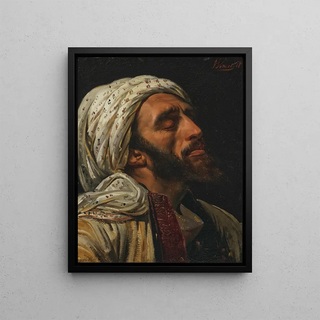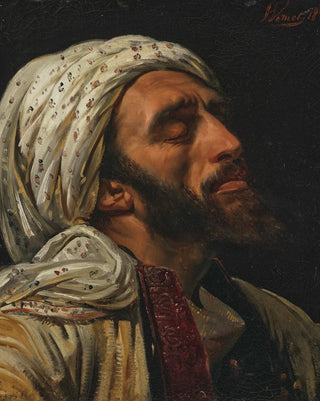Art print | Portrait of an Arab man - Horace Vernet


View from behind

Frame (optional)
Portrait of an Arab man - Horace Vernet – Captivating Introduction
The "Portrait of an Arab man" by Horace Vernet is an iconic artwork that embodies exoticism and the allure of the Orient in the 19th century. This painting, rich in colors and details, transports the viewer to a world where Arab culture is highlighted with rare sensitivity. Vernet, as an artist, manages to capture not only the physical features of his model but also an essence, an atmosphere that evokes stories of travels and discoveries. Through this portrait, the artist invites us to explore a fascinating cultural dimension while revealing his own perspective on a often misunderstood world.
Style and uniqueness of the work
Vernet's style is characterized by an exceptional mastery of portraiture, where every detail is carefully considered to create a lively and expressive image. In "Portrait of an Arab man," the richness of textures and the depth of colors play a crucial role. The subject's face, marked by distinctive features, is illuminated by a delicate light that emphasizes his penetrating gaze. The traditional clothing, adorned with subtle patterns, testifies to artisanal craftsmanship, while the overall composition exudes visual harmony. Vernet manages to transcend mere representation to offer a true window into his model's soul, making this work a perfect example of Orientalist art, where authenticity and aesthetics meet.
The artist and his influence
Horace Vernet, born in 1789, was a French painter whose work was deeply influenced by his era, but also by his travels around the world. Influenced by Romantic currents and Orientalist movements, Vernet established himself as a master of portraiture and historical painting. His passion for the Orient, which he discovered during his journeys in North Africa and the Near East, fueled his creativity and enriched his repertoire. Vernet also played a key role in representing the Other, offering a nuanced and respectful vision of the cultures he encountered. His influence endures today, both in the art world and in the way we perceive cultural representations through the lens of the

Matte finish

View from behind

Frame (optional)
Portrait of an Arab man - Horace Vernet – Captivating Introduction
The "Portrait of an Arab man" by Horace Vernet is an iconic artwork that embodies exoticism and the allure of the Orient in the 19th century. This painting, rich in colors and details, transports the viewer to a world where Arab culture is highlighted with rare sensitivity. Vernet, as an artist, manages to capture not only the physical features of his model but also an essence, an atmosphere that evokes stories of travels and discoveries. Through this portrait, the artist invites us to explore a fascinating cultural dimension while revealing his own perspective on a often misunderstood world.
Style and uniqueness of the work
Vernet's style is characterized by an exceptional mastery of portraiture, where every detail is carefully considered to create a lively and expressive image. In "Portrait of an Arab man," the richness of textures and the depth of colors play a crucial role. The subject's face, marked by distinctive features, is illuminated by a delicate light that emphasizes his penetrating gaze. The traditional clothing, adorned with subtle patterns, testifies to artisanal craftsmanship, while the overall composition exudes visual harmony. Vernet manages to transcend mere representation to offer a true window into his model's soul, making this work a perfect example of Orientalist art, where authenticity and aesthetics meet.
The artist and his influence
Horace Vernet, born in 1789, was a French painter whose work was deeply influenced by his era, but also by his travels around the world. Influenced by Romantic currents and Orientalist movements, Vernet established himself as a master of portraiture and historical painting. His passion for the Orient, which he discovered during his journeys in North Africa and the Near East, fueled his creativity and enriched his repertoire. Vernet also played a key role in representing the Other, offering a nuanced and respectful vision of the cultures he encountered. His influence endures today, both in the art world and in the way we perceive cultural representations through the lens of the






